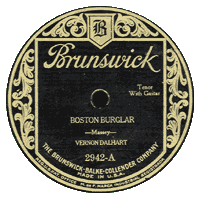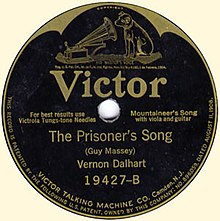Vernon Dalhart
Vernon Dalhart (born April 6, 1883 in Jefferson , Texas as Marion Try Slaughter , † September 14, 1948 in Bridgeport , Connecticut ) was an American singer and one of the first early stars of country music .
Life
Beginnings
Marion Try Slaughter came from a wealthy Texas rancher family. He first worked as a cowboy before studying classical music at the Dallas Conservatory. In 1910 the family moved to New York City, where Vernon initially worked in a piano shop. Here he took the stage name Vernon Dalhart (composed of the Texan cities Vernon and Dalhart). His career as an opera and operetta tenor began as early as 1912 with a supporting role in Puccini's "Girl of the Golden West". His name first appeared in the Edison Diamond record catalog in June 1915, so it is believed that it was at that time that he recorded his first records. Over 400 operetta recordings were made between 1916 and 1923.
Career
The first musically registered record was made in December 1916 with a Just Word of Sympathy . The first hit parade was Till The Clouds Roll By (duet with Kathryn Irving) from August 1917, which reached 10th place. His first country songs (which were called "Old Time Music" or "Hill Billy" at the time) were written in April 1918, Hush-a-bye Ma Baby with Marion Evelyn Cox was the first. His first session for Victor was on November 6, 1918, when he recorded the Al Jolson hit Rock-a-Bye Your Baby with a Dixie Melody , which wasn't released until February 1919.
Since February 1918, Dalhart also recorded for the Brunswick label. The Boston Burglar / Wild And Reckless Hobo was created for this label in New York on June 24, 1925 .
Dalhart released records constantly, often in parallel with different record labels, until he finally had his breakthrough with Wreck of the Old 97 / The Prisoner's Song . The first version recorded for Victor Records dates from August 13, 1924. Subsequently, another 9 versions were created for other record companies. B-side The Prisoner's Song (with Dave Kaplar's Melodists; released October 3, 1924) became its first and only # 1 chart, and subsequently sold over 7 million copies. The Prisoner's Song (supposedly composed by Dalhart's cousin Guy Massey) is actually a fusion of fragments of various other pieces. The main model was Here's Adieu To All The Judges And the Juries , an English piece from 1906. Another adapted piece was Meet Me By The Moonlight by JA Wade from 1826, a well-known composer of the time. Dalhart sang - without making an exception - at almost every record company east of the Mississippi and recorded the Prisoner's song for at least 50 labels with total sales of 25 million copies.
Dalhart produced other singles with high intensity. However, the former operetta singer was soon ousted by authentic hillbilly musicians . The sales of his records declined when the stock crisis of 1929 brought the record industry to a standstill. On May 1, 1939, he had his last recording session for RCA Victor, where a total of 6 tracks were recorded. Then his record career came to an end. He kept himself afloat for a while as a singing teacher, then worked as a night porter in a hotel and finally died on September 14, 1948. He was the undisputed greatest star of the genre during these years and the first country singer to achieve national fame was also noticed abroad.
Although Vernon Dalhart had hardly given new musical impulses, he was an important pioneer for the nationwide acceptance of country music. Almost single-handedly, he opened up access to hillbilly music to large sections of the population. For his services he was inducted into the Country Music Hall of Fame in 1981.
statistics
Under more than 100 different pseudonyms (depending on the source between 110 and 133), he published around 800 songs on over fifty labels between 1915 and 1932 with an estimated turnover of at least 75 million records, two thirds of which can be attributed to country music by today's standards are. Long-time producer Ralph Peer confessed to Variety magazine in October 1955: “Vernon Dalhart was never a hillbilly performer. He had the unusual ability to adapt hillbilly to suit the taste of the other population: he was a pseudo-hillbilly ”.
Discography (selection)
Dalhart's entire discography fails for several reasons. The high number of recordings was partly made under pseudonyms, and a large number of the tracks were recorded in parallel for over fifty record companies. Example is his biggest hit The Prisoner's Song : Victor 19427-B, 1924; Columbia 257-D, 1924; Edison 51459, as Vernon Dalhart & Co., 1925; Brunswick 2900,1925; Bell 340, 1925; Regal 9795, 1925; Cameo 708, 1925; Perfect 12644 / Supertone S-2000, 1930; Apex [Canada] 8428, 1926; Cylinder: Edison [Blue Amberol] 4954, 1925. Therefore, the following list is limited to the titles noted in the hit parade or those that are musically significant. The data is the recording data.
- Just A Word Of Sympathy / Robert Lewis: I Know I Got More Than My Share (Columbia A2108), September 1916
- Can't Yo Heah Me Callin 'Caroline (Blue Amberol 3231), July 1917
- There's Egypt in Your Dreamy Eyes (Blue Amberol 3244), August 1917
- Till The Clouds Roll By (with Kathryn Irving) / You Said Something (Emerson 7192; Starr 7607), August 1917
- Hush-a-bye Ma Baby (with Marion Evelyn Cox) / The Missouri Waltz (Blue Amberol 3454), April 1918
- Till We Meet Again (with Gladys Rice) (Blue Amberol 3670), March 1919
- Tuck Me to Sleep (in My Old 'Tucky Home) / B-side by Charles Hart & Elliott Shaw (Victor 18807), September 1, 1921
- Al Jolson: April Showers / Weep No More, My Mammy (Columbia A3500), October 22, 1921
- Edwin Dale: That's How I Believe In You / I Want My Mammy (with Al Bernard) (Columbia 3520), November 1921
- Dear Old Southland (Amberol 4508), May 1922
- Bruce Wallace & Elliott Shaw: Sweetest Little Rose In Tennessee / The Pal That I Loved (Stole The Gal That I Loved) (Okeh 40177), July 30, 1924
- Wreck Of The Old 97 / The Prisoner's Song (Victor 19427), August 13, 1924
- In The Baggage Coach Ahead (March 19, 1925) / I'll Never Forget My Mother And Home (Victor 19627), (February 25, 1925)
- The Death of Floyd Collins / Wreck Of The Shenandoah (Victor 19779), September 9, 1925
- The Convict And The Rose / Little Rosewood Casket (Victor 19770), August 26, 1925
- Governor's Pardon / The Engineer's Child (Victor 19983), March 2, 1926
- I Lost A Wonderful Pal-Rudolph Valentino / There's A New Star In Heaven Tonight (Columbia 718D), August 27, 1926
- Miami Storm / An Old Fashioned Picture (Columbia 15100D), September 23, 1926
- Al Craver: Wreck Of The Royal Palm Express / Vernon Dalhart: Wreck Of The Number Nine (Columbia 15121D), January 14, 1927
- When The Roses Bloom Again / Mississippi Flood (Victor 20611), April 27, 1927
- The Gypsy's Warning / My Carolina Home (Victor 20795) April 12, 1927
- My Blue Ridge Mountain Home (with Carson Robison) / Oh Dem Golden Slippers (with Carson Robison) (Victor 20539), March 9, 1927
- Lucky Lindy / Lindbergh (The Eagle Of The USA) (Columbia 1000D), May 24, 1927
- If Your Love Like The Rose Should Die (with Carson Robison) / Memory That Time Cannot Erase (Victor 21094), July 21, 1927
- When The Sun Goes Down Again (with Charles Hart) / The Old Gray Mare (Banner 2180), October 27, 1927
- Hallelujah! I'm A Bum / The Bum Song (Columbia 1488D), July 30, 1928
- Al Craver: The Crow Song / Al Craver: Farm Relief Song (Columbia 15449D), August 22, 1929
- Johnny Darlin '/ You'll Never Take Away My Dreams (Bluebird 8170), April 1939
Web links
Individual evidence
- ↑ the information varies a lot, but it was the best-selling country record of the pre-electrical phase; Joseph Murrells: Million Selling Records. From the 1900s to the 1980s. An illustrated directory. Arco, New York NY 1985, ISBN 0-668-06459-5 , pp. 19 f. The majority of the specialist literature assumes 7 million copies. The title was the first million seller of country music.
- ↑ Jack Palmer: Vernon Dalhart. First Star Of Country Music. Mainspring Press, Denver, Colo. 2005, ISBN 0-9772735-0-4 , p. 72.
- ↑ collected by Dr. Gardiner by George Blake; Gardiner Hp. 308, George Blake, St Denys, Southampton; May 1906.
- ^ Joseph Murrells: Million Selling Records. From the 1900s to the 1980s. An illustrated directory. Arco, New York NY 1985, ISBN 0-668-06459-5 , p. 20.
- ^ Bill C. Malone, Judith McCulloh (Eds.): Stars of Country Music. University of Illinois Press, Urbana IL 1975, ISBN 0-252-00527-9 , p. 78.
| personal data | |
|---|---|
| SURNAME | Dalhart, Vernon |
| ALTERNATIVE NAMES | Marion Try Slaughter (real name) |
| BRIEF DESCRIPTION | American singer and country musician |
| DATE OF BIRTH | April 6, 1883 |
| PLACE OF BIRTH | Jefferson , Texas |
| DATE OF DEATH | September 14, 1948 |
| Place of death | Bridgeport (Connecticut) |


